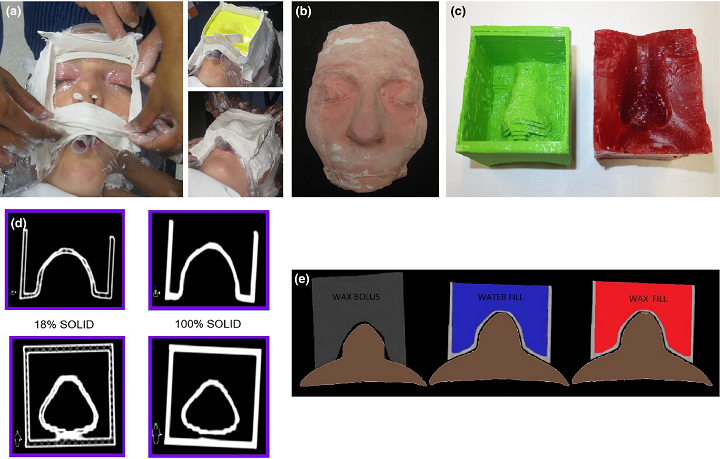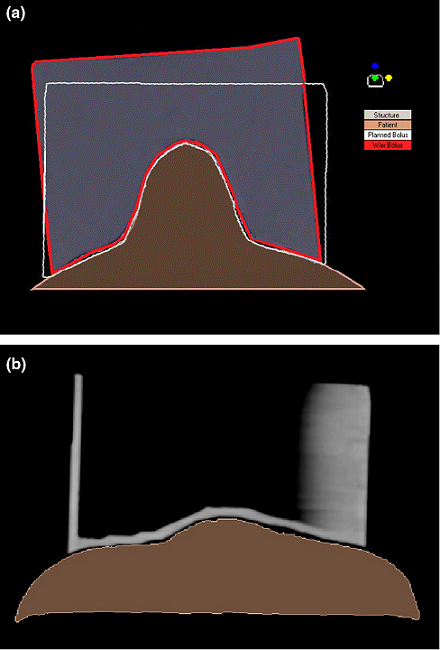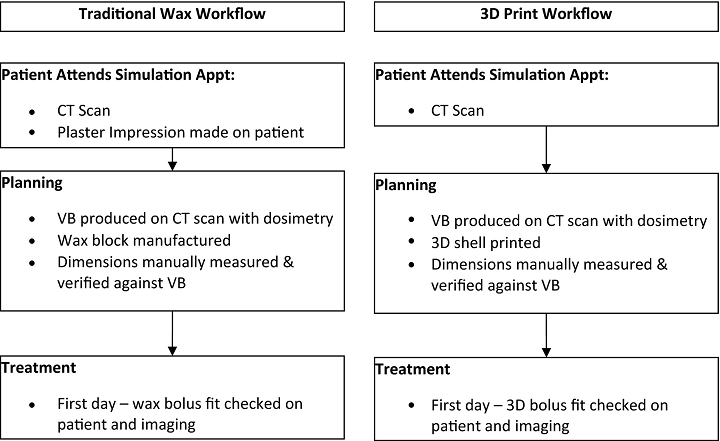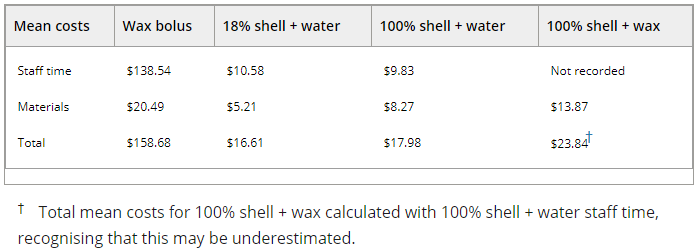Boluses are used often to protect the body from radiotherapy targeted at specific areas, and 3D printing can help streamline their production. Four Australian researchers published a paper, titled “Comparison of 3D printed nose bolus to traditional wax bolus for cost-effectiveness, volumetric accuracy and dosimetric effect,” about their work evaluating the dosimetric and volumetric, and cost, differences between a 3D printed nose bolus and one made with traditional wax.
“Three‐dimensional printing allows the conversion of digital models from data sets created via 3D ultrasound, computed tomography (CT) and magnetic resonance imaging into physical objects,” the team wrote. “In radiotherapy, 3D printed bolus is gaining momentum as the ideal patient bolus due to its durability, and superior patient surface contact over manually manufactured wax or gel bolus.”
Because of its contour changes, the nose is one of the most difficult areas to treat when it comes to skin cancer. But, to ensure that a full dose of radiotherapy is delivered to the patient’s skin surface, along with a homogenous dose distribution to the nose, it’s important that the bolus covers and conforms to the nose.

Bolus Construction: (a) Creating a plaster impression, (b) plaster impression, (c) 3D printed nose bolus without fill (green) and wax bolus (red), (d) 3D shell with varied internal fill, 18% print fill and 100% print fill and (e) Nose bolus: wax (grey), 3D print and water fill (blue), 3D print and wax fill (red).
It’s a labor intensive process to make a nose bolus out of wax, as the technician’s skill level can affect the dosimetric and volumetric accuracy, and there can also be variations from the process itself, like imperfect skin contact or air cavity flaws. But a 3D printed bolus doesn’t have these issues.
“This study aimed to examine the volume, dimensional and dose differences between manually manufactured wax bolus and a 3D printed shell to the virtual bolus demonstrated in a radiotherapy plan for photon treatment to the nose, and to explore which type of bolus is more cost‐effective to produce,” the researchers explained.
The team enlisted 24 volunteers, and took plaster impressions of their noses using alginate and Plaster of Paris. Each positive plaster impression was CT scanned in 2 mm slices, and the scans were imported into the treatment planning system (TPS), contoured, and then “3D planned with virtual bolus and parallel opposed 6 MV lateral fields with collapsed cone algorithm.” Each virtual bolus (VB) plan was manufactured the traditional way, using wax, and then 3D printed out of PLA on an Ultimaker 2+.
A duplicate was fabricated for each 3D printed shell in order to check for conformity of fit and reproducibility. The 3D printing parameters included:
- 0.2 mm layer height
- 0.5 mm external perimeter thickness
- 0.8 mm top/bottom thickness
- 100% and 18% fill density
“To compare volume variations and dosimetry, each constructed bolus was CT scanned and a plan replicating the reference plan fields generated,” the researchers wrote.
Each bolus was contoured, and then assessed via CT scanning for any volume variations from the “reference plan’s VB contours.” Then, the plaster impression plans were copied to the CT image data set for the two types of bolus, and the team recorded and compared the dose at four different points.
“Points A, B and C were placed as close as possible to the same position across plans, accepting differences in exact point position (real slice or between slices) and that the bolus was not perfectly straight on each scan,” the researchers explained. “Additionally, a pseudo‐PTV was created on the VB plan, copied to all other bolus data sets, and maximum and mean doses to this volume recorded.”

Data analysis. (a) Volume difference of wax, 18% shell 3D print and 100% shell 3D print to the virtual bolus, (b) dimensional difference of wax, 18% shell 3D print and 100% shell 3D print to the virtual bolus.
They also computed dose calculations for more dosimetric analysis – once on the 18% infill shells with water fill, and twice on the 100% shells, with water fill and then with wax fill. CT scans were performed, and the team calculated the difference in dose distribution for each defined point, and the maxium and mean doses to the pseudo-PTV for both the original reference plan and the boluses.

Nose bolus. (a) Difference between planned (white outline) and manufactured wax nose bolus (red outline) and (b) demonstration of an indistinct bolus edge.
The researchers wrote, “Mean volume differences between the virtual bolus (VB) and wax, and the VB and 18% and 100% 3D shells were −3.05 ± 11.06 cm3, −1.03 ± 8.09 cm3 and 1.31 ± 2.63 cm3, respectively. While there was no significant difference for the point and mean doses between the 100% 3D shell filled with water and the VB plans (P> 0.05), the intraclass coefficients for these dose metrics for the 100% 3D shell filled with wax compared to VB doses (0.69–0.96) were higher than those for the 18% and 100% 3D shell filled with water and the wax (0.48–0.88).”

Dose point difference from reference plan. The outliers can be attributed to the same scans. The 18% shell outliers all belong to the same single subject’s plan as generated on the CT scan of their physical 18% shell nose bolus, and the outliers on the 100% shells are all from the same three volunteers plan generated on the CT scan of their physical 100% shell nose bolus.
The manufacturing time, and material costs, of fabricating the boluses were also analyzed. The team focused on consumable costs for this, and did not include the 3D printer’s purchase cost, maintenance and future replacement of its parts, and the tools and water bath for the wax bolus. Three of the 48 3D printed boluses did not completely print, and time lost on these was also left out of the cost analysis.
You can see in the table below that average costs for materials and staff time were higher for the wax boluses than for the 3D printed ones. Average time to 3D print the 18% infill shells was 529 minutes, while it took 747 minutes to print the 100% infill shells.
“As the 18% shells were converted and completed prior to all the 100% shells, the total cost of staff time is higher for the 18% shell group due to staff being more familiar with the process of DICOM to .stl file conversion for the 100% shell group,” the researchers explained.
Overall, the 3D printed boluses for photon nose treatments were more accurate and cost-effective than their wax counterparts, and will likely result in a better experience for patients.
“When printed in 100% shell infill density, and filled with water, 3D bolus shells accurately replicate the reference plan dosimetry. Three‐dimensional printed bolus shells produce superior bolus geometry, are more cost‐effective to produce than traditional wax bolus and do not require the same technical skills for production as traditional wax bolus,” the researchers concluded.
Discuss this and other 3D printing topics at 3DPrintBoard.com or share your thoughts below.
Subscribe to Our Email Newsletter
Stay up-to-date on all the latest news from the 3D printing industry and receive information and offers from third party vendors.
Print Services
Upload your 3D Models and get them printed quickly and efficiently.
You May Also Like
Consolidation in AM: How 2025 Is Shaping the Industry’s New Normal
The first half of 2025 has been marked by a clear shift in the additive manufacturing (AM) industry. Companies are no longer just focused on developing new tech by themselves....
Etsy Design Rule Change Reduces Selection of 3D Printed Goods
Online marketplace Etsy has implemented a rule change requiring all 3D printed goods on the site to be original designs. The update to the site’s Creativity Standards states, ¨Items produced using...
U.S. Congress Calls Out 3D Printing in Proposal for Commercial Reserve Manufacturing Network
Last week, the U.S. House of Representatives’ Appropriations Committee moved the FY 2026 defense bill forward to the House floor. Included in the legislation is a $131 million proposal for...
Transforming From Tourist to Native: Duro CEO Michael Corr Explains Why the Company Rebuilt its PLM Software on AI
In these early innings of the AI boom, many market analysts have expressed concern that AI spend has gotten too far ahead of the technology’s proven ability to deliver significant...



































